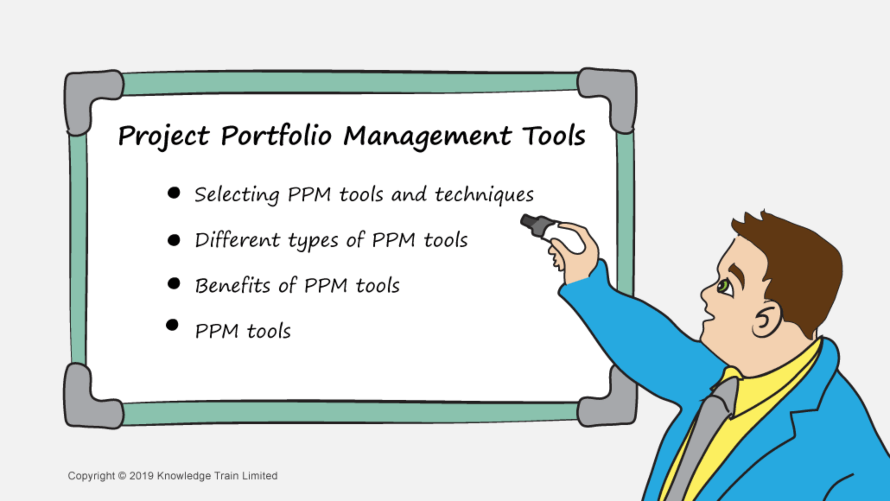
Introduction

Selecting PPM tools and techniques
The PMO will normally select appropriate PPM tools and techniques. When doing so it is always best to consider the PPM maturity of the organisation. Tools can be expensive. Off-the-shelf packages doing everything can be tempting but can also be a waste of money if not used. It might be the case that a cheaper, simpler tool can be more effective than a more complex, more expensive tool.
Having said that, many PPM tools are built around best practices and unless the organisation has very specific requirements which require a custom-built solution, most package tools will be adequate for many organisations.
Different types of PPM tools
Tools can be deployed in a single office or distributed across the organisation. Tools can be used individually, collaboratively or in an integrated way. The PMO provides training on tools and can also provide specialist consultancy to projects, programmes, and portfolios for issues which arise from using PPM tools.
Individual tools
This is typically where a project manager uses a tool such as planning software or a spreadsheet on a single change initiative (programme or project). There might be several instances of the tool in use by different individuals. But each person uses it on a single change initiative.
Collaborative tools
This is where multiple people access a single set of data through a tool. There might be several instances of the tool across the organisation. Each change initiative will have multiple users collaborating through the tool.
Integrated tools
This is where many people can access multiple data sets spanning multiple change initiatives. There is usually a single instance of the tool and the ability of the tool to link data from multiple change initiatives. Enterprise project portfolio management software is an example of an integrated tool.
Benefits of PPM tools
If a project portfolio management tool gets embedded within an organisation there are several benefits:
- Increased efficiencies of PPM processes;
- Improved compliance with business processes;
- More timely data to support decision-making;
- Improved quality of decision-making information;
- Improved decision-making;
- Improved management across geography;
- Improved staff competence;
- Rationalization of legacy systems;
Therefore, if your organisation is considering implementation of a PPM toolset to support its project portfolio management or project management office (PMO) plans, then this list of benefits could be considered as part of a business case to fund the tool.
PPM tools
Tools to support portfolio, programme and project management are often chosen by the people responsible for managing the project management office (PMO), or enterprise PMO if it exists at the highest level within the organisation.
The tools authorised for use by the PMO might be as common as desktop productivity software such as spreadsheets, or slide decks. They can equally be extremely sophisticated and wide-ranging tools.
These are some of the collaborative and integrated toolsets available.
Strategic mapping software
These tools enable users to map programmes and projects to its resulting outputs, outcomes, benefits, and strategy.
Enterprise PPM tools (EPM)
These are designed specifically to be used within enterprise PPM environments. They can capture plans, resources, risks, issues, and project documentation, including version control.
Enterprise architecture tools
These tools model the organisation’s business structure, processes and can map projects from the current situation to the desired future situation (the change).
Knowledge management tools
These tools enable the sharing of information and learning from it. Some examples are wikis, FAQs, intranets.
Performance management tools
These tools align the expected project or programme performance with strategic objectives and track the actual performance.
Risk management tools
These enable a common, integrate and systematic approach to the identification and management of risks and issues.
Requirements management tools
These enable project scope to be defined by the capture, analysis, tracing, and prioritisation of detailed project requirements.
PPM techniques
The techniques applied within a PPM environment can be highly complex. When selecting appropriate tools and techniques to use, consideration must be given to the organisation’s maturity.
Portfolio prioritisation and optimisation
This technique enables programmes and projects to be categorised and ranked according to one or more criteria. The most common criteria are financial, strategic alignment, risk, and complexity.
This technique enables the organisation to take effective decision-making to direct resources at change initiatives which are more strategically aligned.
Management dashboards
This technique highlights exception and highlight based reporting which enables senior management to quickly decide whether a change initiative is on track in terms of progress. A dashboard can be presented as part of a portfolio or programme status report, or it can be delivered electronically with the ability to drill-down into the data using a PPM software tool.
This technique is designed to quickly provide decision-makers with the clear information needed for timely and effective decision-making without getting overcome with the details.
If you work in a PMO and need to get a better understanding of the types of tools which can be useful in project, programme and portfolio environments, consider taking a P3O® course. P3O is the best practice PMO framework for PMO professionals.
P3O® is a registered trademark of AXELOS Limited, used under permission of AXELOS Limited. All rights reserved.








